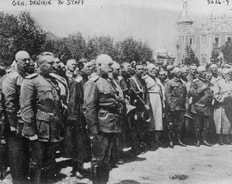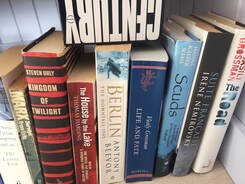 I have both read and written a lot about the pogroms in Ukraine, which were at their peak a hundred years ago. Like Holocaust literature, the more one reads, the more one ceases to be shocked and horrified. I thought that reading about the pogroms would no longer have the searing impact on me that it once did, but I have found that a new book published this month still has the ability to sicken. The work, by Nokhem Shtif, was first published in Yiddish 1923, but now appears in English for the first time translated and annotated by Maurice Wolfthal as The Pogroms in Ukraine, 1918-19: Prelude to the Holocaust. Shtif was editor-in-chief of the editorial committee for the collection and publication of documents on the Ukrainian pogroms, which was founded in Kiev in May 1919. Shtif focuses specifically on atrocities committed by the Volunteer Army, also known as the White Army, under General Anton Denikin, as opposed to the myriad other armies and militarised groups – banda as my grandmother called them – that were rampaging violently across Ukraine at the time. The number of Jews murdered in Ukraine in the aftermath of the Russian Revolution is estimated at anywhere between 50,000 and 200,000, with up to 1.6 million injured, attacked, raped, robbed, or made homeless in the largest outbreak of anti-Jewish violence before the Holocaust. The number of individual pogroms is estimated at more than 1,200. “The Jews were attacked by a number of different groups of perpetrators including Anton Denikin’s Russian Volunteer Army, Simon Petliura’s Army of the Ukrainian Republic, various peasant units, hoodlums, anarchists, and the Bolshevik Red Army. “These attacks stemmed from a number of grievances: accusations of supporting the enemy side, the chaos following the collapse of the old order, the aftermath of World War I and of the Russian Revolution, and a widespread anti-Semitism, after the dissolution of the Russian and Habsburg Empire.” So writes the Berlin-based historian Grzegorz Rossolinski-Liebe in his preface to the book. The relative lack of literature and research on these events provides some explanation for why the Ukrainian pogroms have garnered so much less attention than the Holocaust that followed some 20 years later. Of the research that does exist, much focuses on the nationalist leader Petliura, the subject of my December 2018 blog post. When it comes to Denikin, “the crimes committed by his army have not been forgotten but they were neither investigated as thoroughly as the massacres by the Petliura army nor did they arouse any major controversies, because none tried to systematically or deliberately deny them as the Ukrainian nationalists did in the case of Petliura’s soldiers”, Rossolinski-Liebe argues. But Denikin’s army was unique among the banda in that it murdered Jews in an orderly and methodical way, clearing out the Jewish population from the towns and villages it raided using many of the practices that would be adopted by the Nazis two decades later. The author’s aim is to demonstrate that the pogroms were an integral part of the Volunteer Army’s military campaign, much as the murder of the Jews was for the Nazi regime. The Volunteer Army was a force made up of former Tsarist officers that aimed to drive out the Bolshevik regime and restore every aspect of Russia to its pre-Revolutionary days. Their aims, as Shtif says were, “The land must be returned to the aristocracy. The labor movement must be crushed […] Jews will continue to be second-class citizens, oppressed and subservient.” Pogroms were a way of preventing Jews from gaining the equal human rights that the revolution had granted them. Shtif is convincing in his explanation of the causes of the pogroms: “For the reactionaries pogroms are a way to prevent Jews from obtaining equal rights, which the hated Revolution granted them. Pogroms are the first step towards reducing them to a state of slavery. That principle […] is at the root of the pogroms. In the eyes of reactionaries Jews are creatures without rights. And as soon as anyone dares to give them their rights, they are outraged and they burn to put the crown back on the head of perverted justice. In the eyes of reactionaries, of course, Jews have no rights.” In describing the events of the pogroms, I feel traumatised yet again knowing that my grandmother and her family lived through and survived such terrifying times. So much of what Shtif writes corroborates what my grandmother said about the pogroms, and the many different banda that perpetrated them. The towns my great-grandparents came from – Pavoloch and Makarov – both in Kiev province, receive several mentions in the book, each one sending shivers down my spine. “So horrendous are the accounts that they are difficult to grasp,” Shtif writes…. “There are no words…” It often feels in these troubling times of the early 21st century that swaths of the population in many parts of the world are returning to the extreme nationalism that pervaded a century ago. We seem to be revisiting that world of religious extremism, with murderous attacks on immigrant communities and a US president who vilifies those of other faiths and nationalities. We would be well served to learn lessons from the past and prevent the current polarisation of society from leading once again to the kind of mass violence that tore Ukraine apart a hundred years ago. The Pogroms in Ukraine, 1918-19: Prelude to the Holocaust is published by Open Book Publishers
0 Comments
 I’ve had a copy of Vasily Grossman’s Life and Fate taunting me from my bookshelf for several years. I’ve been meaning to read it, really meaning to, ever since my Dad gave it to me. But at nearly 900 pages, somehow I’ve never found the time. I have read other, less hefty, works by Grossman in the meantime, and have found them fascinating. Now a new biography of the writer by Alexandra Popoff, a former Moscow-based journalist now based in Canada, is finally goading me into action and I plan to devote the coming summer to finally reading Life and Fate. Grossman is an intriguing character, a celebrated Soviet writer who later turned against the regime. His conscience forced him into the tormented double life of a Soviet intellectual, trying to express his doubts about the Soviet system in ways that would not lead to his arrest. Life and Fate, however, was an incendiary work by Soviet standards. A panoply of characters and sub-plots centred around the events of World War II, it is often compared with Leo Tolstoy’s monumental War and Peace, which shares a similar structure based on an earlier war – Napoleon’s unsuccessful Russia campaign. But what made it so controversial to the Soviet censors is its comparison of the USSR with Nazi Germany and Stalin’s persecution of the Jews with Hitler’s holocaust. Mikhail Suslov, the chief Communist party ideologue, told Grossman, “Your book contains direct parallels between us and Hitlerism…Your book defends Trotsky. Your book is filled with doubts about the legitimacy of our Soviet system.” Its publication was out of the question. Grossman was born in 1905 to a Jewish family in Berdichev, Ukraine, a town with one of Europe’s largest Jewish populations. His early novels, published in the 1930s, were mostly typical of Soviet literature at the time and Grossman was promoted by the regime’s most influential writer Maxim Gorky. But even then, some of his short stories were banned and he could be considered lucky for avoiding arrest during Stalin’s purges of the late 1930s. During World War II, Grossman worked as a journalist for the army newspaper Red Star, reporting from the front line on the battle for Stalingrad and the fall of Berlin. He gained access to the Nazi death camp at Treblinka, near Warsaw, shortly after it was destroyed. This chilling experience formed the basis for his article ‘The Hell of Treblinka’, published in September 1944, which was one of the first accounts of the true horror of the Holocaust to reach the outside world. In it he writes: “It is infinitely painful to read this. The reader must believe me when I say that it is equally hard to write it. ‘Why write about then?’ someone may well ask. ‘Why recall such things?’ “It is the writer’s duty to tell the terrible truth, and it is a reader’s civic duty to learn this truth. To turn away, to close one’s eyes and walk past is to insult the memory of those who have perished.” Grossman completed Life and Fate in 1960, at a time when Soviet literature was enjoying a period of relative liberalism during the post-Stalin Khrushchev ‘thaw’. But like Boris Pasternak’s better-known work Doctor Zhivago, the novel could not be published in its homeland. Suslov told Grossman that there was no question of Life and Fate seeing the light of day for another 200 years. Every copy of the manuscript was confiscated by the KGB in 1961, with orders to take not just the typewritten pages, but any sheets of used carbon paper and even the typewriter ribbons used to write it. It is thanks to the emigré dissident Vladimir Voinovich that the book made its way to the West on microfilm. The Russian text was published abroad in 1980 and in English five years later. Life and Fate was finally published in the Soviet Union in 1988, some 24 years after Grossman’s death. In a couple of months or so I will write my own thoughts about the novel, once I’ve completed the monumental task of reading it. Vasily Grossman and the Soviet Century by Alexandra Popoff is published by Yale University Press Life and Fate by Vasily Grossman is published by Vintage Classics |
Keeping stories aliveThis blog aims to discuss historical events relating to the Jewish communities of Ukraine, and of Eastern Europe more widely. As a storyteller, I hope to keep alive stories of the past and remember those who told or experienced them. Like so many others, I am deeply troubled by the war in Ukraine and for the foreseeable future, most articles published here will focus on the war, with an emphasis on parallels with other tumultuous periods in Ukraine's tragic history. Archives
March 2024
Categories
All
|
 RSS Feed
RSS Feed
